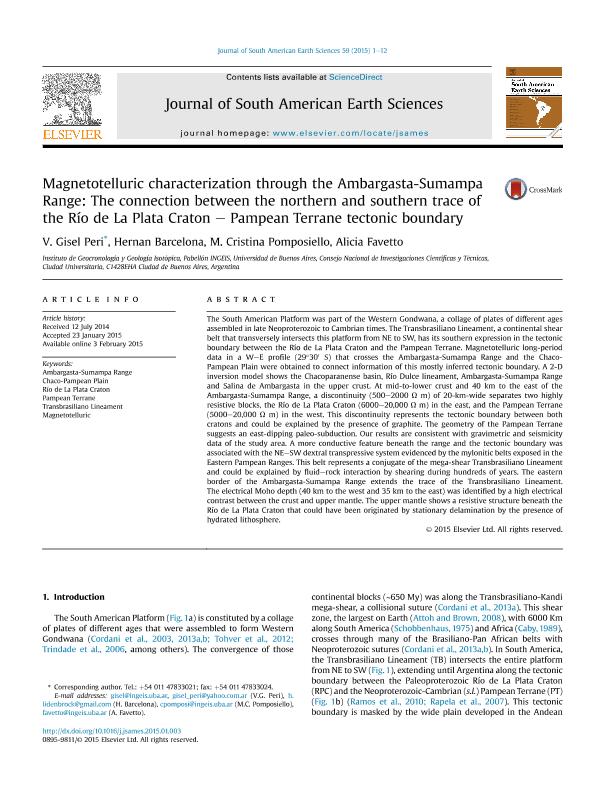Mostrar el registro sencillo del ítem
dc.contributor.author
Peri, Verónica Gisel

dc.contributor.author
Barcelona, Hernan

dc.contributor.author
Pomposiello, Maria Cristina

dc.contributor.author
Favetto, Alicia Beatriz

dc.date.available
2022-12-27T11:44:18Z
dc.date.issued
2015-01
dc.identifier.citation
Peri, Verónica Gisel; Barcelona, Hernan; Pomposiello, Maria Cristina; Favetto, Alicia Beatriz; Magnetotelluric characterization through the Ambargasta-Sumampa Range: The connection between the northern and southern trace of the Río de La Plata Craton e Pampean Terrane tectonic boundary; Pergamon-Elsevier Science Ltd; Journal of South American Earth Sciences; 59; 1-2015; 1-12
dc.identifier.issn
0895-9811
dc.identifier.uri
http://hdl.handle.net/11336/182448
dc.description.abstract
The South American Platform was part of the Western Gondwana, a collage of plates of different ages assembled in late Neoproterozoic to Cambrian times. The Transbrasiliano Lineament, a continental shear belt that transversely intersects this platform from NE to SW, has its southern expression in the tectonic boundary between the Río de La Plata Craton and the Pampean Terrane. Magnetotelluric long-period data in a W-E profile (29°30' S) that crosses the Ambargasta-Sumampa Range and the Chaco-Pampean Plain were obtained to connect information of this mostly inferred tectonic boundary. A 2-D inversion model shows the Chacoparanense basin, Río Dulce lineament, Ambargasta-Sumampa Range and Salina de Ambargasta in the upper crust. At mid-to-lower crust and 40km to the east of the Ambargasta-Sumampa Range, a discontinuity (500-2000Ωm) of 20-km-wide separates two highly resistive blocks, the Río de La Plata Craton (6000-20,000Ωm) in the east, and the Pampean Terrane (5000-20,000Ωm) in the west. This discontinuity represents the tectonic boundary between both cratons and could be explained by the presence of graphite. The geometry of the Pampean Terrane suggests an east-dipping paleo-subduction. Our results are consistent with gravimetric and seismicity data of the study area. A more conductive feature beneath the range and the tectonic boundary was associated with the NE-SW dextral transpressive system evidenced by the mylonitic belts exposed in the Eastern Pampean Ranges. This belt represents a conjugate of the mega-shear Transbrasiliano Lineament and could be explained by fluid-rock interaction by shearing during hundreds of years. The eastern border of the Ambargasta-Sumampa Range extends the trace of the Transbrasiliano Lineament. Theelectrical Moho depth (40km to the west and 35km to the east) was identified by a high electrical contrast between the crust and upper mantle. The upper mantle shows a resistive structure beneath the Río de La Plata Craton that could have been originated by stationary delamination by the presence of hydrated lithosphere.
dc.format
application/pdf
dc.language.iso
eng
dc.publisher
Pergamon-Elsevier Science Ltd

dc.rights
info:eu-repo/semantics/openAccess
dc.rights.uri
https://creativecommons.org/licenses/by-nc-sa/2.5/ar/
dc.subject
AMBARGASTA-SUMAMPA RANGE
dc.subject
CHACO-PAMPEAN PLAIN
dc.subject
MAGNETOTELLURIC
dc.subject
PAMPEAN TERRANE
dc.subject
RÍO DE LA PLATA CRATON
dc.subject
TRANSBRASILIANO LINEAMENT
dc.subject.classification
Geología

dc.subject.classification
Ciencias de la Tierra y relacionadas con el Medio Ambiente

dc.subject.classification
CIENCIAS NATURALES Y EXACTAS

dc.subject.classification
Geoquímica y Geofísica

dc.subject.classification
Ciencias de la Tierra y relacionadas con el Medio Ambiente

dc.subject.classification
CIENCIAS NATURALES Y EXACTAS

dc.title
Magnetotelluric characterization through the Ambargasta-Sumampa Range: The connection between the northern and southern trace of the Río de La Plata Craton e Pampean Terrane tectonic boundary
dc.type
info:eu-repo/semantics/article
dc.type
info:ar-repo/semantics/artículo
dc.type
info:eu-repo/semantics/publishedVersion
dc.date.updated
2022-12-22T16:05:11Z
dc.journal.volume
59
dc.journal.pagination
1-12
dc.journal.pais
Estados Unidos

dc.description.fil
Fil: Peri, Verónica Gisel. Consejo Nacional de Investigaciones Científicas y Técnicas. Oficina de Coordinación Administrativa Ciudad Universitaria. Instituto de Geocronología y Geología Isotópica. Universidad de Buenos Aires. Facultad de Ciencias Exactas y Naturales. Instituto de Geocronología y Geología Isotópica; Argentina
dc.description.fil
Fil: Barcelona, Hernan. Consejo Nacional de Investigaciones Científicas y Técnicas. Oficina de Coordinación Administrativa Ciudad Universitaria. Instituto de Geocronología y Geología Isotópica. Universidad de Buenos Aires. Facultad de Ciencias Exactas y Naturales. Instituto de Geocronología y Geología Isotópica; Argentina
dc.description.fil
Fil: Pomposiello, Maria Cristina. Consejo Nacional de Investigaciones Científicas y Técnicas. Oficina de Coordinación Administrativa Ciudad Universitaria. Instituto de Geocronología y Geología Isotópica. Universidad de Buenos Aires. Facultad de Ciencias Exactas y Naturales. Instituto de Geocronología y Geología Isotópica; Argentina
dc.description.fil
Fil: Favetto, Alicia Beatriz. Consejo Nacional de Investigaciones Científicas y Técnicas. Oficina de Coordinación Administrativa Ciudad Universitaria. Instituto de Geocronología y Geología Isotópica. Universidad de Buenos Aires. Facultad de Ciencias Exactas y Naturales. Instituto de Geocronología y Geología Isotópica; Argentina
dc.journal.title
Journal of South American Earth Sciences

dc.relation.alternativeid
info:eu-repo/semantics/altIdentifier/doi/http://dx.doi.org/10.1016/j.jsames.2015.01.003
Archivos asociados
